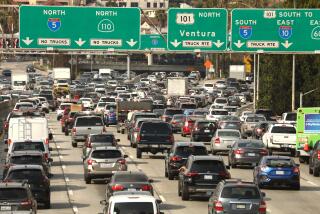EPA Offers First Alternative-Vehicle Emission Rules
- Share via
WASHINGTON — The Environmental Protection Agency proposed the first emission standards Wednesday for snowmobiles, all-terrain vehicles, forklifts and a range of other vehicles that account for a surprisingly large portion of several dangerous air pollutants.
The proposed rules would reduce carbon monoxide emissions from these vehicles by 56% and hydrocarbon and nitrogen oxide emissions by nearly 80% by the time the regulations are fully phased in, according to the EPA.
The proposal could help alleviate a range of health problems, especially respiratory impairments, and environmental problems such as regional haze in national parks.
“When fully implemented, this action will not only protect public health but will help to restore the view of our nation’s treasured scenic parks and wilderness areas,” said EPA Administrator Christie Whitman.
Since these vehicles have remained unregulated while emission standards on automobiles, trucks and buses have been increasingly tightened, they pose an inordinate threat to air pollution for their size and numbers. The vehicles that would be regulated by the proposal are responsible for about 13% of hydrocarbon emissions, 6% of carbon monoxide emissions and 3% of nitrogen oxide emissions.
The proposal is significant on its own merits and because it is the first major air pollution regulation that the Bush administration has drafted that is not in response to a Clinton-era proposal or regulation.
Some environmentalists were disappointed with the proposal, even while they conceded that it represented a step forward for air quality. It fell short, they said, because snowmobiles would not be held to as strict a standard as some other vehicles; noise pollution was not addressed; and manufacturers were not required to label products with information about emissions and air quality.
But the head of the International Snowmobile Manufacturers Assn. argued that the regulations seem too strict for a vehicle that owners use only about 12 weekends a year on average and not in cities, which have the toughest air pollution problems.
The proposal would also set standards that would encourage manufacturers of off-road motorcycles and all-terrain vehicles to switch from two-stroke engines to four-stroke engines, beginning in 2006. Four-stroke engines are cleaner and more efficient than two-stroke engines. The agency sets an even more stringent standard for manufacturers to meet by 2009.
For snowmobiles, the EPA has proposed that manufacturers reduce hydrocarbon and carbon monoxide emissions by 30% in 2006 and 50% in 2010.
Scott Kovarovics, a spokesman for Natural Trails & Waters Coalition, an alliance of 80 environmental and public health groups, worries that under the regulations, even a decade from now, snowmobiles still will be clouding vistas and hurting public health, especially in areas where the EPA has shown that snowmobiles are harming air quality. Those areas include Spokane, Wash.; Fort Collins, Colo.; and Klamath Falls and Medford, Ore.
“It’s extremely incremental,” Kovarovics said. He and other environmentalists had called on the EPA to require snowmobile manufacturers to use only the cleaner four-stroke engines.
One area that stands at particular risk is Yellowstone National Park, where a dispute over banning snowmobiles has yet to be resolved.
“There’s no question that under this proposal the park would continue to be at significant risk for serious air pollution because the majority of these machines would continue to be powered by two-stroke engines,” Kovarovics said.
Public hearings on the proposal are set for Oct. 24 in Washington and Oct. 30 in Denver.






